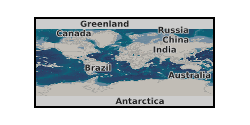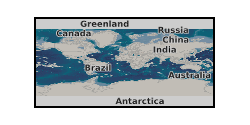Neodymium isotopes
Type of resources
Topics
Keywords
Contact for the resource
Provided by
Years
Formats
Representation types
Update frequencies
-

We report sedimentary coatings and fish teeth neodymium isotope values – tracers for water-mass mixing – from deep-water International Ocean Discovery Program (IODP) Site U1438 (4.7 km water depth) in the Philippine Sea, northwest Pacific Ocean. The time period encompasses the last 20 million years.
-

Neodymium (Nd) isotope data measured from fossil fish debris and sediment leaches collected from IODP Sites U1512, U1513, U1514 and U1516.
-

The file contains the validation data on certified reference material for Nd isotope measurement, the LA-MC-ICP-MS composite Pb isotope ratios and Nd isotope time series for Tropic Seamount, north-east Atlantic Ocean. The dataset spans a deposition history covering the last 75 Ma. The record was obtained by analysis of hydrogenetic ferromanganese crust samples recovered during the 2016 JC142 expedition of the MarineE-Tech project.
-

This dataset comprises neodymium (Nd) and strontium (Sr) isotope compositions measured on 72 sediment samples, from IODP Expedition 374 Site U1521 to the Ross Sea. These were collected on the RV JOIDES Resolution. Shipboard biostratigraphy and magnetostratigraphy suggests the samples are mainly early Miocene in age (McKay et al., 2019). The uppermost samples do, however, include younger Plio-Pleistocene sediments. Neodymium and Sr isotope analyses were conducted using a multi-collector inductively coupled plasma mass spectrometer (MC-ICP-MS) and a thermal ionisation mass spectrometer (TIMS), respectively, in the MAGIC laboratories at Imperial College London. Neodymium and Sr isotopes in sediments can be compared to measurements from terrestrial rock samples, allowing the changing provenance of the sediments to be traced. This dataset therefore provides information on how erosion by Antarctica’s ice sheets bordering the Ross Sea has changed over time. Neodymium isotopes are reported in the epsilon notation, which denotes the deviation in parts per 10,000 from the present-day composition of the Chondritic Uniform Reservoir (143Nd/144Nd = 0.512638) (Jacobsen and Wasserburg, 1980).
-

Neodymium (Nd) concentrations, Nd radiogenic isotopes (143Nd/144Nd) and Nd stable isotopes (d146/144Nd) for chondritic meteorites, terrestrial basalts and mantle rocks, and rock reference materials.
-
This dataset comprises neodymium (Nd) isotopic compositions measured on 145 samples of aragonitic deep-sea corals from the Drake Passage of the Southern Ocean. Most of the samples were previously collected on expeditions NBP0805 and NBP1103 on the RV Nathaniel B. Palmer. The samples include glacial, deglacial and Holocene aged specimens and most are from 0-40 ka BP (thousand years before present) based on uranium-thorium dating. Neodymium isotope analyses were conducted by either thermal ionisation mass spectrometry (TIMS) or multi-collector inductively-coupled plasma mass spectrometry (MC-ICP-MS) in the MAGIC laboratories at Imperial College London by David Wilson, Torben Struve and Tina van de Flierdt. In the modern ocean, dissolved Nd isotopes are a quasi-conservative water mass tracer, while past compositions of seawater are recorded in deep-sea corals. This dataset therefore provides evidence on the proportions of Atlantic versus Pacific waters admixed in the Southern Ocean through time, which places crucial constraints on global deep water chemistry and circulation dynamics during past climate events. Funding was provided by the NERC grant NE/N001141/1. Related datasets are associated with grant NE/N003861/1. Both grants funded the project "Bridging the Timing Gap: Connecting Late Pleistocene Southern Ocean and Antarctic Climate Records".
-

A worldwide compilation of 645 analyses of Sm and Nd concentrations, and Nd isotopes, in fine-grained continental sedimentary rocks with a range of deposition ages. These data were used in Dhuime et al. (2017, Sedimentary Geology 357, 16-32) to calculate the variation in the Nd model age of fine-grained continental sediments as a function of their age of deposition.
-

This dataset includes the (stable) oxygen and carbon isotopic composition of benthic foraminifer tests (n= 686) and the (radiogenic) isotopic composition of the terrigenous fraction of marine sediments (n= 75), all sampled from Eocene to Oligocene-aged sediments recovered at Ocean Drilling Program (ODP) Site 689 and 690 (Maud Rise, Southern Ocean)
 NERC Data Catalogue Service
NERC Data Catalogue Service